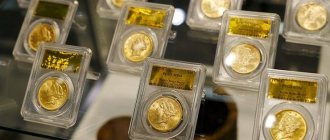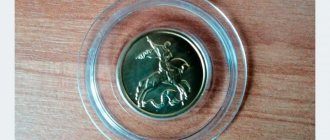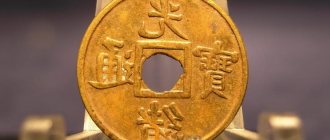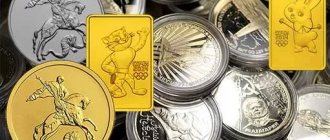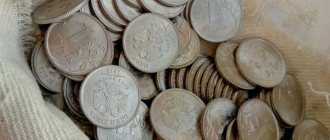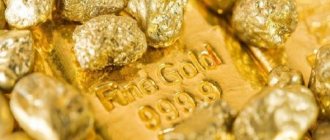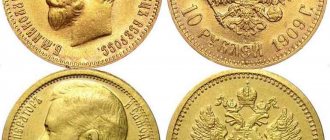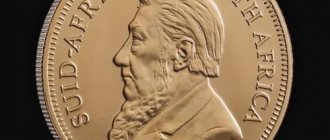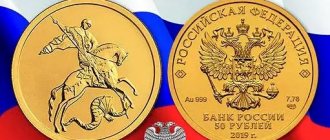“The wise investor’s best guarantee against risk is not retreat, but diversity,” with this phrase British billionaire businessman David Harding calls for investing in various investment areas. One of them is the purchase of precious metals. To activate it, transactions with investment coins in Russia are not subject to VAT. Russians who invested in 2015-2016 in gold coins, by the time the new decade arrived, they were big winners. First, monetary gold rose in price due to the collapse of the ruble exchange rate, and then its stock quotes increased. The result was an almost twofold increase in the price of gold in ruble equivalent. Investing in coins offers a wide range of options, ranging from the antique market to modern pieces. It is easier for a novice investor to understand the basics based on the investment coins of our time.
What to buy?
To begin with, you should clearly understand in which country you will sell the purchased coins. Whether it will be easy to sell what you bought depends on their popularity and the degree of trust in them. For example, the basic format of the international market is troy ounce (31.1 grams). Therefore, in the USA, Great Britain, Germany, Austria and many other countries, the maximum transaction is the purchase or sale of ounce coins. The world format of one ounce has developed historically, since this is the weight of pure gold that was in the very first bullion coin - the South African Krugerrand. The status of a legal means of payment (although this coin was not originally intended for payments), for example, ensured great demand for it among US citizens. After all, in this country, from 1933 to 1974, owning gold bars and coins was prohibited.
Currently, monetary gold, along with bullion gold, is a commodity in the United States and is actively used for investment. Since 1986, the United States has issued its own line of gold bullion coins, the American Gold Eagle. Silver investors are familiar with the American Silver Eagle dollar coins, better known as the Walking Liberty coins. No less popular on the investment market are the Canadian “Gold Maple Leaf” series and the Australian “Nuggets” with an image of a nugget or a kangaroo on the reverse. Among the most famous investment coins in the world is the Austrian Philharmoniker. Buying or selling these issues is easy to do in any developed country in the Western world.
In Russia, the purchasing power of the population is lower, so until recently the most popular product was quarter ounces (7.78 grams). Investors did not see much difference in the type of coin (modern “Victorious”, Soviet “Sower” or gold 10 rubles of Nicholas II). Interest in “ocmushki” - gold five-ruble coins of Nicholas II was much lower, and coins of other formats (for example, the Russian or Soviet 100-ruble half ounce) represented a tiny part of the market. The sharp rise in gold prices radically changed the market. The purchasing power of Russians has decreased, so the golden quarter has moved into the category of expensive goods, and purchases of five-ruble coins have increased. Those who previously bought quarters for the same price began to purchase them. But the general trend of rising gold prices has aroused investor interest in other formats. Perhaps it was this fact that led the Central Bank to add three new formats to the 2021 issue plan for gold “Pobedonostsev”: 200 rubles - 31.11 grams (1 ounce) of pure gold, 100 rubles - 15.55 grams (1/ 2 ounces) of pure gold and 25 rubles - 3.11 grams (1/10 ounce) of pure gold. The estimated circulation is up to 100,000 pieces for each item.
Is it worth buying Proof quality collectible coins for investment? Yes, if you are prepared for the fact that their collectible component will not play any role in a quick sale in 99% of cases. In addition, investment coins are sold without VAT, while this markup exists for collectible coins. When selling, the difference in the value of an investment and a collection coin that arises due to different taxation will not be returned to you. Another thing is that after a sharp rise in metal prices, profits can significantly cover the premium paid. The concept of “investment coin” is still quite vague. For example, SberBank classifies only the “Sower” chervonets of 1975-1982, the “St. George the Victorious” series (coins of ordinary minting quality) and the “Talismans of Sochi 2014” bullion coins as investment coins.
Collecting foreign coins made of precious metals is not a cheap pleasure. The number of Russian numismatists in this area is not so large. In this regard, the owner of even a very rare foreign specimen can hardly count on its quick sale at the price of numismatic catalogs. In most purchases, he will be offered an amount even lower than the exchange price of the metal. Therefore, it makes sense to buy foreign gold or silver only if it is planned to be sold on the international market.
Profitable investments in gold coins
In a volatile market, investing in gold coins is the most attractive way to protect your savings. Fluctuating exchange rates, falling interest rates on deposits, and unreliable mutual funds make citizens think about how not to lose their savings. The banking sector has long disappointed Russians; rising inflation is outpacing interest rates on deposits. Gold, silver, platinum and palladium are highly liquid assets. When world prices for precious metals rise, investing in them can bring additional income. The attractiveness of such investments is also that they can be quickly implemented.
Is it profitable to buy precious metals in the form of jewelry? It is no secret that the gold from which jewelry is made is much lower in cost than the price of the same metal in bullion or bank coins. This is due to the fact that alloys are used to make jewelry (585 fineness indicates the mass fraction of impurities), and ingots and chervonets contain 999 fine gold. It follows that jewelry can only be considered an investment if it has historical and artistic value. It is important to remember the average liquidity of such assets - they cannot be sold quickly, only at a significant discount.
Ingots or chervonets
Investing in coins is a good way to save money. Despite the fact that the value of gold itself is also subject to strong fluctuations in different economic periods, it is most reasonable to consider this metal as a long-term investment. Even in the most protracted crisis there will be objects buying gold. Interest in this metal is eternal, since the supply of precious metals on Earth is exhaustible; time has no power over it.
You can purchase measured gold bars at a bank. When making a physical purchase, you will have to pay 18% VAT on top of the cost of the bullion, and by opening an impersonal metal account in a Russian bank, this tax can be avoided. In addition, a gold bar has a standard size - 1 kg of gold. Not everyone can afford to buy precious metal in kilograms. For smaller purchases there is a metal account. An alternative to an impersonal account is a gold coin. This is the same ingot, but lighter in weight. It does not have any numismatic or other value; the value is affected only by the content of precious metal in it.
Investments in gold chervonets have their disadvantages, for example, a higher price than bullion gold. This is due to additional minting costs. But they have many more advantages. Firstly, the smaller the coin, the more liquidity it has. Secondly, there is no need to store a certificate, which is necessary when purchasing an ingot. When selling a gold bar, the bank will definitely require it, but when selling a coin, it will not. The third argument in favor of coins is that they are not profitable to counterfeit. There is much more benefit from a counterfeit bar, and it is much more difficult to verify the bar. It’s unlikely that anyone will cut off half of it to see what’s inside. We are talking about transactions concluded in banks. It is not worth buying either coins or bars from private individuals.
Types of gold coins
What coins are sold to individuals today? There are gold and silver legal tender coins and bullion coins. Here are some of them:
- Australian nugget.
- Australian Lunar Series gold coins.
- Austrian Philharmonicist.
- Britannia.
- American Golden Eagle.
- Chinese Panda.
- American Buffalo.
- Chervonets of the Republic of Congo “For good luck”.
- Money of the Republic of Macedonia “Year of the Rooster”
- Coin of the Republic of Macedonia "Angel on a Cart".
Sberbank coins are a worthy alternative to overseas coins:
- Golden chervonets “Sower”.
- Zodiac signs.
- George the Victorious.
- Silver coin of the Mother of God of Vladimir.
- History of monetary circulation in Russia.
- Russian ballet.
- Winter Olympic Games 2014.
- Silver coin “for all occasions” Horseshoe for good luck.
Which coins are better depends on the patriotism and taste of the buyer. Their liquidity is approximately the same, the denomination is indicated on the money itself, and the cost depends on the price of a gram of gold. Russian coins can be purchased at any bank licensed to trade in precious metals. The most favorable rate is announced at Sberbank. Foreign coins are also sold in Russian banks, but do not forget about the value added tax, which will increase the cost of any chervonets by 18%.
A good way to save on VAT is to buy gold bullion coins from foreign banks. They can be imported into the territory of the Russian Federation without quantitative restrictions, according to the Decree of the President of the Russian Federation.
Pros and cons of buying gold assets
Investing in precious metal coins has many positive aspects. This is high liquidity, and the impossibility of wear over time, and the constantly growing price per gram, and other factors. What are the downsides to buying gold? It is not necessary to list the disadvantages that apply to all types of investment, such as fraud, theft, loss, bank failure, etc. Arguments against gold:
- By investing in precious metals, a person will not be able to receive capitalization or increase his capital. He only saves savings, but they do not work for him.
- The sale of gold will always be carried out at an inflated rate, and the purchase - at an underestimated rate. In this case, the bank makes money from the person. Purchasing metal from a private person is dangerous - you can buy a fake. In addition, an investor will be able to buy a bullion or coin with VAT, and sell without tax. But on the amount he receives for gold, he will have to pay a personal income tax of 13%.
- The need to analyze the market before buying or selling precious metals. There is a period when prices rise, at which point it is advisable to sell metal. When the price per gram drops, you need to buy.
- Physical metal will require storage and transportation costs.
Gold assets can be in the form of futures contracts. They have all the advantages of an impersonal metal account, but their disadvantage is that they are short-term. Futures contracts for precious metals (gold, silver, platinum and palladium) are unique financial instruments that provide everyone with access to the precious metals market. However, if the bank does not go bankrupt, then an impersonal metal account is the most attractive investment portfolio.
Where to buy?
At the exchange price of gold or silver, you can buy coins anywhere that guarantees their authenticity. However, we must remember that banking institutions can introduce their own commissions or markups. And in pawn shops, coins may have cuts, which will complicate their sale in the future. Proof quality coins, also exhibited in pawn shops, often have coin field defects (fingerprints, scratches, acid stains), which completely destroys their collectible component.
It is worth asking in advance whether this coin was issued in any special capsule or other branded packaging. When purchasing, always check the integrity of the capsule (no cracks or even scratches), as well as its originality. With non-original or damaged packaging, a number of banks buy back coins at a large discount or refuse to buy them at all.
When investing in coins, it doesn’t hurt to remember four simple rules:
- Calculate the approximate profitability of the coin relative to the funds spent on it.
- Determine the investment period (the interval between purchase and sale).
- Don’t be lazy to monitor the price of precious metals every day, building a chart of growth or decline.
- Get as much information as possible about the selected coin (storage details, specific cases of problematic sales, possible collectible component, etc.).
As you know, the group of noble (or precious) metals consists of a trinity - gold, silver and platinum, as well as five platinoids - osmium, iridium, ruthenium, rhodium and palladium. The latter of them has long been used for minting investment coins and has earned the trust of many investors. Here the pioneers were exotic countries - Sierra Leone (1966) and Tonga (1967). Over half a century, various countries around the world have issued more than a hundred palladium coins. True, most of them have modest circulations. The most impressive productions appeared within the series “American Eagle” (USA), “Maple Leaf” (Canada) and “Russian Ballet” (USSR/Russia). In addition, there are bimetallic coins made of gold and palladium. But the most amazing coin of the British Virgin Islands is the “Four Elements” with the image of a sailboat, which consists of all four investment metals with a total weight of half a troy ounce: gold (4.221 grams), silver (4.56 grams), platinum (2.78 grams) and palladium (3.9 grams).
But is it worth paying attention to the remaining four? After the sharp increase in the price of rhodium (up to $10,000 per troy ounce in 2008), mints began to think about producing banknotes from this metal. Here the main difficulty is not so much its cost as its refractoriness. The first to market a coin-shaped token made of rhodium (2009) was the American company COHEN MINT. However, this one-gram product was initially declared not as a means of payment, but as an investment object. Other countries are also starting to look at rhodium. An example is the 2021 Tuvalu $100 "Southern Sea Dragon" - one ounce of pure rhodium (mintage of 1,000). The Swiss company Produits Artistiques Métaux Précieux is also trying to develop rhodium as an investment product, offering the purchase of rhodium bars in 1 and 5 ounces.
Almost the entire set of precious metals was implemented by Rwanda, which released a set of seven coins in 2015, which, in addition to rhodium, also added ruthenium and iridium. However, it is worth considering that the weight of these miniature coins with a diameter of 11 mm is purely symbolic (4 positions of 1.244 grams each and 3 positions of 0.311 grams each). Actually, this is not so much an investment object as an exotic selection of samples of precious metals, which is almost impossible to quickly sell at a market price. And yet, let us note that the price of a troy ounce of ruthenium at the end of 2021 was $270, iridium - $1,710, and by mid-January 2021, rhodium had risen to a record value of $19,500 per ounce, and by the beginning of March it had come close to a value of $30,000.
Where to sell?
It would seem that any investor has a direct route to the bank. However, in reality, it is the banks that offer the largest gap between the purchase and sale prices. For example, one investor, seeing a significant increase in silver prices, decided to sell all the accumulated ounce silver coins. But he unexpectedly encountered the fact that at that time “St. George the Victorious” cost 1,900 rubles in large banks in the capital, and collectible coins of the same weight cost only 1,300 rubles and only in perfect condition. But organizations that have chosen the purchase/sale of precious metals as their main focus accept both collectible and investment coins closer to the value of stock exchange quotes.
Let us give specific examples of the sale/purchase fork of collectible coins based on quotes from SberBank PJSC for coins made of precious metals (excellent condition) for February 2021. A 5-ounce silver coin (155.5 grams) is sold in offices for 13,990 rubles, and bought back for only 6,000 rubles. For a kilogram coin made of silver, you will have to pay 200,000 rubles upon purchase, and receive only 30,000 rubles when selling in the office. Sberbank sells 5-ounce gold coins for 833,000 rubles and buys them back for 600,000. The situation is even worse with collectible bimetal (gold/silver). The bank sells hundred-ruble coins of the “Golden Ring of Russia” series for 674,000, and buys them back for 156,000 rubles (a difference of more than half a million).
Before selling, it would be a good idea to inquire whether the coin has an increased collectible value. For example, on numismatic forums, 2 rubles from 1999 “Costa Khetagurov” (the “Outstanding Personalities of Russia” series) or all three coins from the 2000 edition of the “Red Book” are several times more expensive than other items of the same series.
At the beginning of 2021, there was a sharp increase in the price of silver ounce three-ruble notes of early issues of Russian (Soviet) Animation. Purchased for several thousand rubles immediately after their release into circulation, coins during this period could be sold at auctions or numismatic forums for an order of magnitude more expensive. But the purchase price in banks did not take into account the collection component of these coins. The Rarity Project focuses on the market passage of coins, so it takes into account not only the metal from which they are made, but also the demand in numismatic circles. You can evaluate your coins here and now.
Operations with coins made of precious metals
JSCB "FORA-BANK" (JSC) invites you to invest part of your funds in gold bars, commemorative or investment coins, and take advantage of the opportunity to open an impersonal metal account.
Services for operations with precious metals
- Sale and purchase of commemorative and investment coins made of precious metals
- Sale of gold bars
- Storing physical metal in a certified storage facility
- Maintaining impersonal metal accounts
- Providing loans in precious metals
- Lending secured by precious metals
Quotes for Russian investment coins
Coin "St. George the Victorious"
| RATING | METAL | TRY | METAL CONTENT IN PURE, G | SALES QUOTE |
| 3 rubles | silver | 999/1000 | 31,10 | 2 700.00 |
| 25 rubles | gold | 999/1000 | 3,11 | 15 000.00 |
| 50 rubles | gold | 999/1000 | 7,78 | 38 000.00 |
| 100 rubles | gold | 999/1000 | 15,55 | 72 000.00 |
| 200 rubles | gold | 999/1000 | 31,10 | 145 000.00 |
Coin quotes in JSCB "FORA-BANK" (JSC) in one file
Limited Edition Commemorative Series
Series: 75th anniversary of the Victory of the Soviet people in the Great Patriotic War of 1941–1945. Release date: 04/27/2020. Catalog number: 5111-0417 Denomination: 3 rubles. Quality: proof. Metal, standard: silver 925/1000. Total weight, g: 33.94 (±0.31). Content of chemically pure metal is not less than, g: 31.10. Diameter, mm: 39.00 (±0.30). Thickness, mm: 3.30 (±0.35). Circulation, pcs.: 7000 pcs.
Series: 75th anniversary of the Victory of the Soviet people in the Great Patriotic War of 1941–1945. Release date: 11/29/2019. Catalog number: 5111-0413 Denomination: 25 rubles. Quality: proof. Metal, standard: silver 925/1000. Total weight, g: 33.94 (±0.31). Content of chemically pure metal is not less than, g: 31.10. Diameter, mm: 39.00 (±0.30). Thickness, mm: 3.30 (±0.35). Circulation, pcs.: 3000 pcs.
Series: 75th anniversary of the Victory of the Soviet people in the Great Patriotic War of 1941–1945. Release date: 11/29/2019. Catalog number: 5111-0152 Denomination: 3 rubles. Quality: proof. Metal, standard: silver 925/1000. Total mass, g: 169.00 (± 0.85) Chemically pure metal content, not less, g: 155.50. Diameter, mm: 60.00 (± 0.50). Thickness, mm: 6.60 (± 0.50). Circulation, pcs.: 1500 pcs.
Series: Let's save our world. Release date: 08/04/2020. Catalog number: 5221-0032; Denomination: 10,000 rubles. Quality: proof-like. Metal, purity: gold 999/1000. Total weight, g: 1004.40 (±3.30); Content of chemically pure metal is not less than, g: 1000.0. Diameter, mm: 100.00 (±0.80). Thickness, mm: 8.50 (±0.40). Circulation, pcs.: 50 pcs.
Series: Let's save our world. Release date: 08/04/2020. Catalog number: 5217-0046. Denomination: 100 rubles. Quality: proof. Metal, purity: gold 999/1000. Total weight, g: 15.72 (±0.15). Content of chemically pure metal is not less than, g: 15.55. Diameter, mm: 30.00 (±0.25). Thickness, mm: 1.70 (±0.20). Circulation, pcs.: 1000 pcs.
Series: Let's save our world. Release date: 08/04/2020. Catalog number: 5216-0123. Denomination: 50 rubles. Quality: proof. Metal, purity: gold 999/1000. Total weight, g: 7.89 (±0.10). Content of chemically pure metal is not less than, g: 7.78. Diameter, mm: 22.60 (±0.15). Thickness, mm: 1.60 (±0.20). Circulation, pcs.: 1000 pcs.
Series: Let's save our world. Release date: 08/04/2020. Catalog number: 5115-0154. Denomination: 25 rubles. Quality: proof. Metal, standard: silver 925/1000. Total weight, g: 169.00 (± 0.85). Content of chemically pure metal is not less than, g: 155.50. Diameter, mm: 60.00 (± 0.50). Thickness, mm: 6.60 (± 0.50). Circulation, pcs.: 1000 pcs.
Series: Let's save our world. Release date: 08/04/2020. Catalog number: 5111-0429. Denomination: 3 rubles. Quality: proof. Metal, standard: silver 925/1000. Total weight, g: 33.94 (±0.31). Content of chemically pure metal is not less than, g: 31.10. Diameter, mm: 39.00 (±0.30). Thickness, mm: 3.30 (±0.35). Circulation, pcs.: 5000 pcs.
Latest coin arrivals
On October 12, 2021, the Bank of Russia will issue into circulation a commemorative silver coin with a face value of 3 rubles “100th anniversary of the State Academic Theater named after Evgeniy Vakhtangov” (catalog No. 5111-0450). A silver coin in the denomination of 3 rubles (the mass of the precious metal in purity is 31.1 g, the fineness of the alloy is 925) has the shape of a circle with a diameter of 39.0 mm.
On October 5, 2021, the Bank of Russia issued a commemorative silver coin “Poet N.A. Nekrasov, on the 200th anniversary of his birth (12/10/1821). Coin of the series “Outstanding Personalities of Russia” (catalog No. 5110-0169). A silver coin in the denomination of 2 rubles (the mass of the precious metal in purity is 15.55 g, the fineness of the alloy is 925) has the shape of a circle with a diameter of 33.0 mm.
On September 10, 2021, the Bank of Russia issued a commemorative silver coin with a face value of 2 rubles. Coin “Writer F.M. Dostoevsky, on the occasion of the 200th anniversary of his birth (11.11.1821)” is published in the series “Outstanding Personalities of Russia” (catalog No. 5110-0168).
The Bank of Russia has put into circulation commemorative coins “Masha and the Bear” of the “Russian (Soviet) Animation” series: a silver coin with a face value of 3 rubles (the mass of the precious metal in purity is 31.1 g, the fineness of the alloy is 925) has the shape of a circle with a diameter of 39.0 mm.
The Bank of Russia issued commemorative coins “Masha and the Bear” of the “Russian (Soviet) Animation” series: a base metal coin with a denomination of 25 rubles with a color coating has the shape of a circle with a diameter of 27.0 mm.
Additional Information
Why should you buy gold?
For thousands of years, gold has been valued for its rarity, beauty and, most of all, its unique ability to retain its real value over the long term. Precious metals and especially gold have a reputation as eternal values, which investors resort to in times of crisis when investments in traditional assets bring only huge losses. Gold continues to be a globally recognized, reliable, inflation-protected investment.
Why is gold rising in price?
The reason for such a sharp rise is a combination of many factors. The supply of gold is limited by natural resources. The possible weakening of the US dollar against major world currencies, the continuing tense international situation - all these factors contribute to the growing popularity of investing in gold, which is explained by its reliability.
How safe is an investment in gold?
Gold is protected from inflation. Unlike other commodities, gold retains its real value over the long term. Gold is a currency without a country, since its value does not depend on the state of the national economy. Gold can be easily sold without high costs at any time. Gold is a convenient form of storing family valuables.
Coins made of precious metals are not afraid of inflation, and over time they only increase in value. In addition, gift coins can become an original and interesting gift for those who value their savings. JSCB Fora-Bank (JSC) offers a wide range of commemorative and investment coins of the Bank of Russia, as well as commemorative coins of foreign countries.
Detailed information on the availability and purchase of coins can be found by calling the contact number of the Unified Information and Consulting Office (JSC):
Telephone (calls within Russia are free).
When to buy?
Like any market asset, investment coins bring the greatest profit if you buy them when the value of the metal falls and sell them when the price peaks. But only investors with extensive experience can guess these parameters. Therefore, if you have free funds, buy investment coins at any opportunity. By carefully monitoring the state of affairs on the exchanges, it is quite possible to understand the general trend in the price of a particular metal.
For example, according to data for the first quarter of 2021, an ounce of palladium on exchanges was quoted more expensive than an ounce of gold, and an ounce of platinum was one and a half times cheaper. But there were periods when the opposite situation developed. Therefore, at this period of time, investors preferred to sell palladium and buy platinum as an undervalued asset that could show explosive growth in the future. “We don't need to be smarter than everyone else. We must be more disciplined than others,” advises the world's most famous investor, Warren Buffett.
